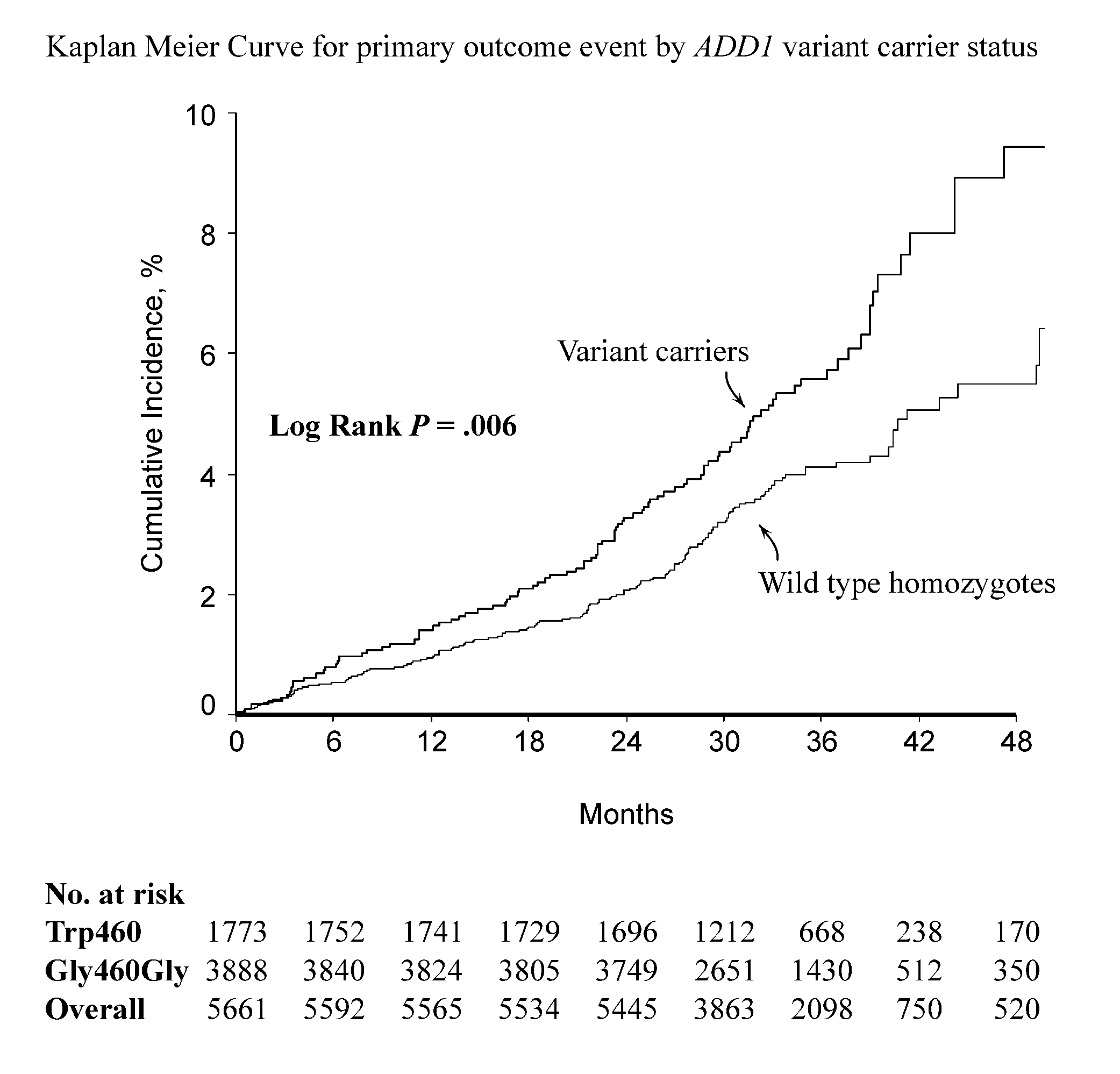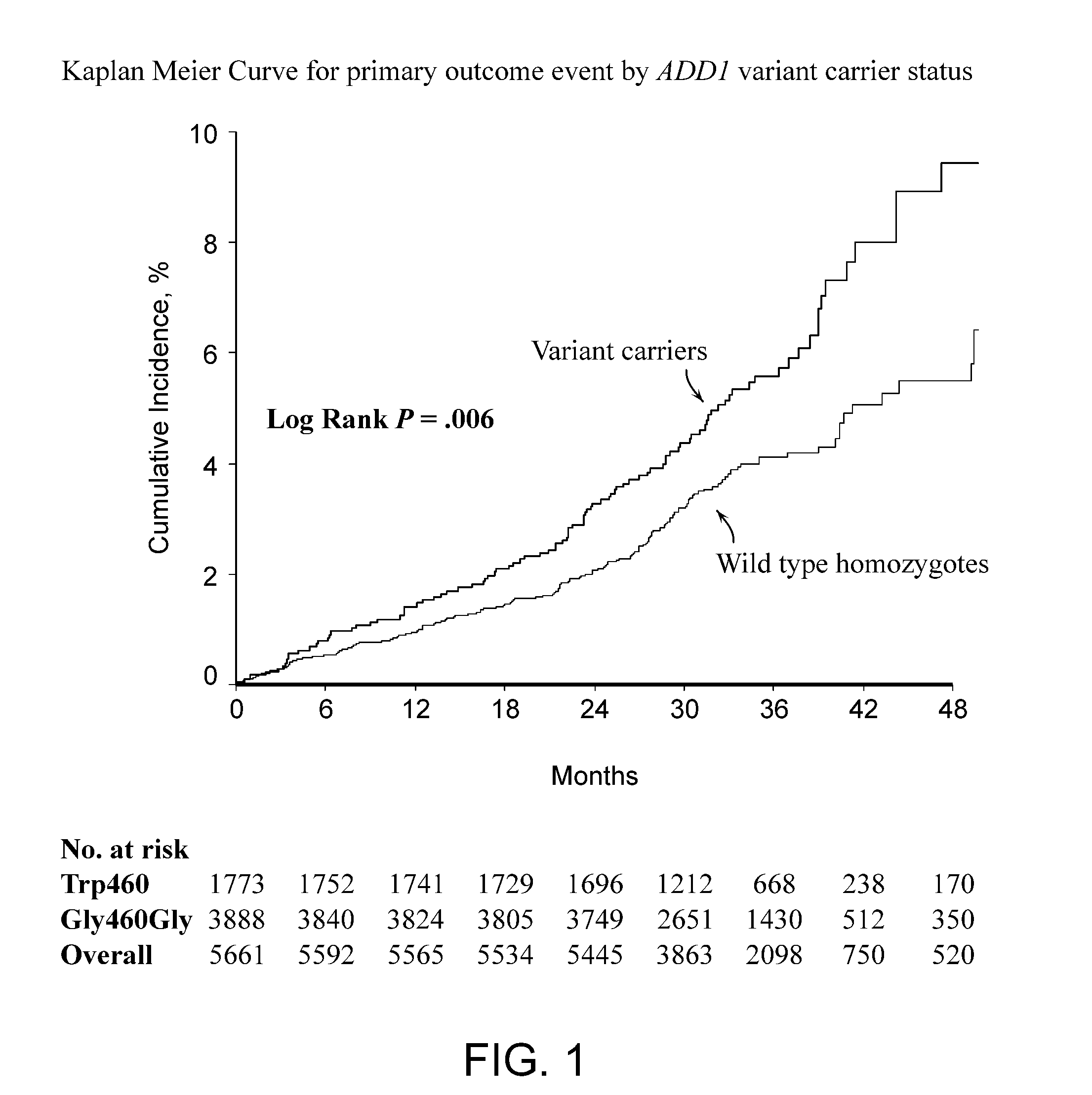Use of Genetic Determinants in Cardiovascular Risk Assessment
a genetic determinant and risk assessment technology, applied in the field of use of genetic determinants in cardiovascular risk assessment, can solve the problem that the empirical approach to identifying appropriate drug therapy for individual patients is not working
- Summary
- Abstract
- Description
- Claims
- Application Information
AI Technical Summary
Benefits of technology
Problems solved by technology
Method used
Image
Examples
example 1
ADD1 460Trp Polymorphism is Associated with Cardiovascular Risk
[0183]The study included 5,979 patients followed over an average of 2.8 years, was ethnically diverse, and had extensive patient level information including well controlled blood pressure and a rigorous adjudication process for adverse outcomes. In hypertensive coronary artery disease patients ADD1 variant carriers showed a 43% (95% CI 11-84%) excess risk for a primary outcome event. No evidence of effect modification of diuretic therapy, age, or other cardiovascular risk factors was observed. These findings identify a gene that contributes to cardiovascular risk. In view of this finding, the invention provides genetic screens that identify those at high risk for adverse cardiovascular outcomes by identifying variations in ADD1. This is the first study to document a main effect of ADD1 on cardiovascular outcomes, and this main effect was not modified by environmental or clinical factors.
[0184]Baseline demographic and stu...
example 2
KCNMB1 Genotype Influences Response to Verapamil SR and Adverse Outcomes
[0205]Baseline characteristics for all INVEST-GENES patients are shown in Table 5.
TABLE 5Baseline characteristics among those with complete Val110Leugenotype*INVEST-GENESCasesControlsCharacteristic(N = 5486)(N = 255)(N = 798)Age, mean (SD), years66.1(9.7)71.6(9.9)69.9(9.3)Women3047(55.5)131(51.4)400(50.1)BP, mean (SD),mmHgSystolic148.0(18.4)150.7(19.0)147.4(19.1)Diastolic85.4(10.7)83.6(11.1)83.5(11.2)Race / ethnicityWhite2076(37.8)152(59.6)468(58.7)Black588(10.7)32(12.6)93(11.7)Hispanic2598(47.4)63(24.7)219(27.4)Other / multiracial224(4.1)8(3.1)18(2.2)BMI, mean (SD),29.3(5.5)27.5(4.8)29.1(5.6)kg / m2Lys65 allele frequencyn / a0.1350.11Leu110 allele0.090.060.09frequencyPast Medical HistoryMyocardial infarction1281(23.4)95(37.3)236(29.6)Angina pectoris4070(74.2)151(59.2)503(63.0)Revascularization >1783(14.3)62(24.3)149(18.7)month agoStroke / TIA381(6.9)36(14.1)73(9.2)Left ventricular823(15.0)45(17.7)139(17.4)hypertrophyHear...
example 3
β1-Adrenergic Receptor Polymorphisms Effect Antihypertensive Treatment
[0242]Patients treated with various antihypertensive therapies show variability in their responsiveness (FIG. 10). FIG. 11 shows the role of the β1-adrenergic receptor in physiology. Common polymorphisms in the β1-adrenergic receptor gene (ADRB1) are associated with the response to drug therapy (FIGS. 12-14) and in particular to β-blocker therapy (FIG. 15). The aim of this study was to evaluate the impact of ADRB1 variants on clinical outcomes in patients with treated hypertension and explore their interaction with antihypertensive drug therapy. Treatment strategies with verapamil SR or atenolol are shown in FIG. 16.
[0243]Hypertensive patients with documented coronary artery disease (n=5,979) were randomized to an atenolol- or verapamil SR-based antihypertensive strategy, with hydrochlorothiazide and / or trandolapril added as needed for blood pressure control (FIG. 16). These patients were genotyped for SNPs in ADR...
PUM
| Property | Measurement | Unit |
|---|---|---|
| temperatures | aaaaa | aaaaa |
| temperatures | aaaaa | aaaaa |
| temperatures | aaaaa | aaaaa |
Abstract
Description
Claims
Application Information
 Login to View More
Login to View More - R&D
- Intellectual Property
- Life Sciences
- Materials
- Tech Scout
- Unparalleled Data Quality
- Higher Quality Content
- 60% Fewer Hallucinations
Browse by: Latest US Patents, China's latest patents, Technical Efficacy Thesaurus, Application Domain, Technology Topic, Popular Technical Reports.
© 2025 PatSnap. All rights reserved.Legal|Privacy policy|Modern Slavery Act Transparency Statement|Sitemap|About US| Contact US: help@patsnap.com



